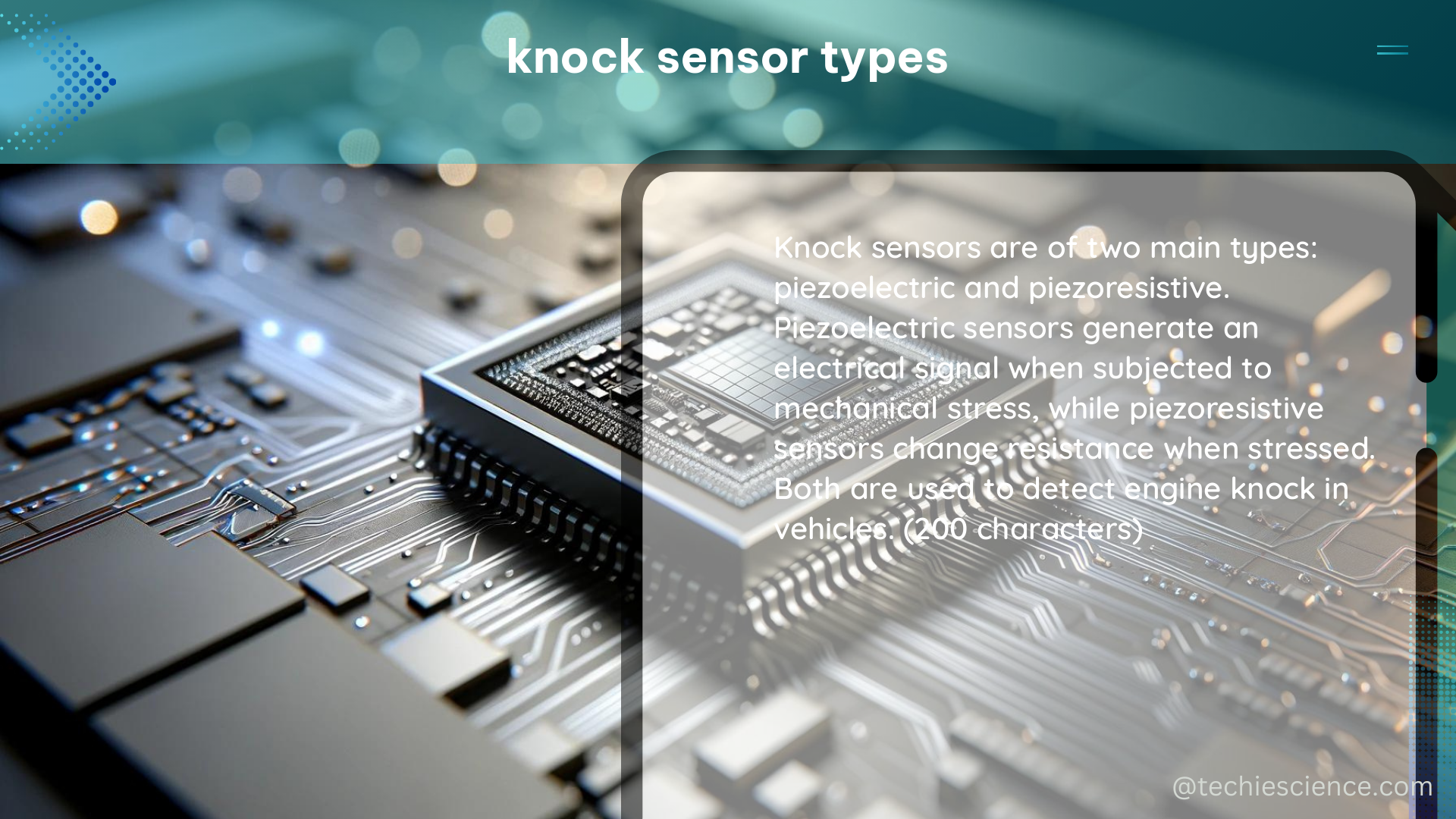Knock sensors are crucial components in internal combustion engines, helping to prevent engine knocking or detonation by adjusting the ignition timing. There are primarily two types of knock sensors: inductive and piezoelectric, each with its own unique characteristics and applications.
Inductive Knock Sensors
Inductive knock sensors, also known as magnetic knock sensors, generate a voltage signal when the ferromagnetic material in the sensor’s core is influenced by the magnetic field of a passing tooth on the reluctor wheel. These sensors are generally less expensive and simpler in design, but they may have lower sensitivity and accuracy compared to piezoelectric sensors.
Technical Specifications of Inductive Knock Sensors
-
Sensitivity: Inductive knock sensors typically have a sensitivity range of 10 to 50 millivolts per knock per degree of crankshaft rotation (mV/(knock*deg)). This means that for every knock detected, the sensor will generate a voltage signal between 10 to 50 millivolts per degree of crankshaft rotation.
-
Frequency Response: Inductive knock sensors have a frequency response of up to 10 kHz, which is suitable for detecting engine knocking in most applications. However, they may not be able to capture the high-frequency vibrations associated with advanced ignition systems.
-
Temperature Range: Inductive knock sensors are designed to operate within a wide temperature range, typically from -40°C to +125°C or higher, to withstand the harsh environment of the engine compartment.
-
Mounting Configuration: Inductive knock sensors can be mounted in various configurations, such as bolt-on, threaded, or stud-mounted, depending on the engine application and manufacturer’s specifications.
-
Durability: Inductive knock sensors are designed to withstand the vibrations, shocks, and high temperatures encountered in the engine compartment, ensuring reliable performance over the lifetime of the engine.
Piezoelectric Knock Sensors

Piezoelectric knock sensors, on the other hand, use piezoelectric crystals that generate an electrical charge when subjected to mechanical stress or deformation. These sensors can provide high-frequency response, accuracy, and sensitivity, making them suitable for modern engines with advanced ignition systems.
Technical Specifications of Piezoelectric Knock Sensors
-
Sensitivity: Piezoelectric knock sensors can have sensitivities up to several hundred millivolts per knock per degree of crankshaft rotation (mV/(knock*deg)), significantly higher than inductive sensors. This increased sensitivity allows for more precise detection of engine knocking.
-
Frequency Response: Piezoelectric knock sensors have a frequency response of up to 20 kHz or higher, enabling them to capture the high-frequency vibrations associated with engine knocking in modern engines with advanced ignition systems.
-
Temperature Range: Like inductive knock sensors, piezoelectric knock sensors are designed to operate within a wide temperature range, typically from -40°C to +125°C or higher, to withstand the harsh environment of the engine compartment.
-
Mounting Configuration: Piezoelectric knock sensors can also be mounted in various configurations, such as bolt-on, threaded, or stud-mounted, depending on the engine application and manufacturer’s specifications.
-
Durability: Piezoelectric knock sensors are engineered to be highly durable, able to withstand the vibrations, shocks, and high temperatures encountered in the engine compartment, ensuring reliable performance over the lifetime of the engine.
Choosing the Right Knock Sensor
When it comes to DIY maintenance or troubleshooting, it is essential to consult the vehicle manufacturer’s specifications and guidelines. This is because the specifications and requirements for knock sensors can vary significantly depending on the engine make, model, and year.
It is important to note that the choice between inductive and piezoelectric knock sensors will depend on the specific requirements of the engine, the ignition system, and the desired level of performance and accuracy. In general, piezoelectric knock sensors are preferred for modern engines with advanced ignition systems, while inductive knock sensors may be more suitable for older or less sophisticated engine designs.
References
- Administrative Changes to AETC TTP11-1, Employment of Basic Flight Maneuvers, Air Force, 2020-01-16, https://static.e-publishing.af.mil/production/1/aetc/publication/aetcttp11-1/aetcttp11-1.pdf
- Check and change ABS and wheel speed sensors, HELLA, https://www.hella.com/techworld/us/Technical/Sensors-and-actuators/Check-change-ABS-sensor-4074/
- Transit Security Design Considerations Final Report November 2004, Federal Transit Administration, https://www.transit.dot.gov/sites/fta.dot.gov/files/docs/ftasesc.pdf

The lambdageeks.com Core SME Team is a group of experienced subject matter experts from diverse scientific and technical fields including Physics, Chemistry, Technology,Electronics & Electrical Engineering, Automotive, Mechanical Engineering. Our team collaborates to create high-quality, well-researched articles on a wide range of science and technology topics for the lambdageeks.com website.
All Our Senior SME are having more than 7 Years of experience in the respective fields . They are either Working Industry Professionals or assocaited With different Universities. Refer Our Authors Page to get to know About our Core SMEs.